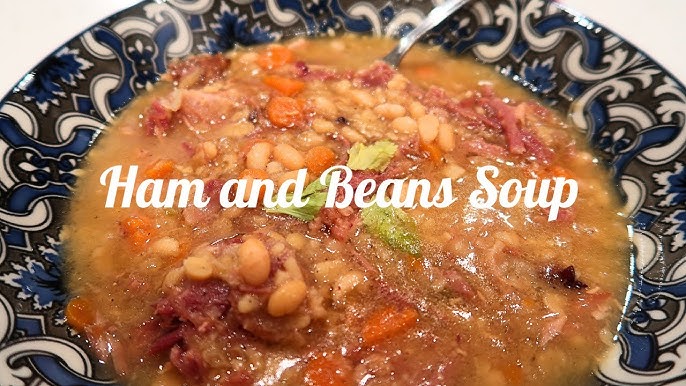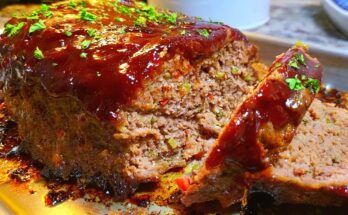Ham and Beans Recipe: Ham and beans are a timeless comfort food that combines hearty flavors with satisfying textures. This dish has been a staple in kitchens for generations, offering warmth and nourishment during chilly evenings or family gatherings. Its simplicity and affordability make it an ideal meal for both beginners and seasoned cooks.
Imagine a steaming bowl filled with tender beans and smoky ham chunks—it’s not just a meal; it’s a hug in a bowl! The flavors blend perfectly, creating a rich and savory experience that’s hard to resist.
Origins and Popularity of Ham and Beans
The origins of ham and beans can be traced back to traditional Southern and Appalachian cuisines, where resourceful cooking methods turned simple ingredients into filling meals. Farmers and homesteaders relied on dried beans and cured meats, like ham hocks, for sustenance during harsh winters.
Today, this dish has found its way into modern kitchens across the globe. Whether cooked slowly on the stovetop, in a crockpot, or an Instant Pot, it continues to capture the hearts of many.
Why You’ll Love This Recipe
- Budget-Friendly – Made with inexpensive ingredients.
- One-Pot Meal – Minimal cleanup required.
- Customizable – Adjust the flavors and spices to suit your taste.
- Great for Leftovers – Tastes even better the next day.
This ham and beans recipe is packed with protein, making it a wholesome meal that keeps you full and satisfied.
Ingredients for Ham and Beans
To make this recipe, you’ll need the following:
- 1 lb dried beans (navy beans, great northern beans, or pinto beans)
- 1 ham bone or 1 lb diced ham
- 1 large onion, chopped
- 3 cloves garlic, minced
- 8 cups water or chicken broth
- 1-2 bay leaves
- 1 tsp dried thyme
- Salt and pepper to taste
Optional Ingredients for Extra Flavor
Want to make it even more flavorful? Try these optional add-ins:
- Carrots and Celery – Adds sweetness and crunch.
- Smoked Paprika or Chili Flakes – For a smoky or spicy kick.
- Ham Hock or Bacon – Enhances the smoky flavor.
- Fresh Herbs (Parsley or Thyme) – Adds freshness before serving.
Choosing the Right Ham for the Recipe
The key to rich flavor lies in the ham you choose. Here are your options:
- Ham Bone – Ideal for extracting deep flavors as it simmers.
- Leftover Ham Chunks – Great for repurposing holiday leftovers.
- Ham Hocks – Smoky and fatty, perfect for infusing flavors.
Tip: If you don’t have a ham bone, use smoked turkey legs as a substitute for a similar flavor profile.
Step-by-Step Cooking Instructions
Step 1: Soaking the Beans for Perfect Texture
Start by rinsing the beans thoroughly under cold water to remove dirt and debris.
- Quick Soak Method: Boil the beans for 2 minutes, remove from heat, and let them soak for 1 hour.
- Overnight Soak Method: Soak the beans in water overnight, ensuring they are fully submerged.
Soaking reduces cooking time and makes the beans easier to digest. Drain and rinse them before cooking.
Step 2: Prepping the Ham for Cooking
If you’re using a ham bone, trim off excess meat and dice it into bite-sized pieces.
- For ham hocks, lightly sear them in a pan to release flavor.
- If using leftover ham, ensure it’s cut into cubes for even distribution.
Pro Tip: Keep the bone in the pot as it adds an extra layer of richness to the broth.
Step 3: Combining Ingredients in a Pot
Place the beans, ham, onion, garlic, bay leaves, and thyme into a large pot.
- Add 8 cups of water or broth. Ensure there’s enough liquid to cover the beans completely.
- Stir gently and bring the mixture to a boil over medium-high heat.
Note: If using a slow cooker, set it to low and cook for 6-8 hours.
Step 4: Cooking Time and Simmering Tips
Once boiling, reduce the heat to low and let the beans simmer uncovered.
- Simmer Time: 2 to 3 hours, depending on the type of beans.
- Stir occasionally and check the water level. Add more liquid if necessary.
The beans should be soft but not mushy, and the ham should easily fall apart.
Step 5: Adding Seasonings and Final Touches
Taste the broth and adjust seasonings as needed.
- Add salt and pepper near the end of cooking to prevent beans from toughening.
- Toss in fresh parsley or a splash of vinegar for brightness before serving.
Pro Tip: For a thicker consistency, mash some beans with a fork or blend a portion of the soup.
Serving Suggestions and Variations
Ham and beans is a hearty dish that can be enjoyed on its own, but pairing it with complementary sides can make it even more satisfying. Here are some ideas to round out your meal:
- Cornbread – A classic Southern pairing that adds a slightly sweet and crumbly texture.
- Crusty Bread or Dinner Rolls – Perfect for soaking up the flavorful broth.
- Rice or Mashed Potatoes – Provides an extra layer of comfort and fills you up.
- Steamed Vegetables – Lighten up the meal with broccoli, green beans, or carrots.
- Pickled Onions or Jalapenos – Adds a tangy contrast to the smoky flavors.
Pro Tip: Serve with a dollop of sour cream or a sprinkle of shredded cheese for a richer taste.
Recipe Variations – Spicing It Up or Keeping It Simple
The beauty of this recipe is its versatility. You can keep it simple or customize it to suit your preferences.
- Spicy Version: Add diced jalapenos, chili flakes, or a splash of hot sauce for heat.
- Vegetable-Packed Version: Toss in carrots, celery, and bell peppers to boost nutrition.
- Cajun Style: Add Cajun seasoning, smoked sausage, and okra for Southern flair.
- Creamy Texture: Stir in heavy cream or blend a portion of the beans for a thicker consistency.
- Smoky Flavor: Incorporate smoked paprika or liquid smoke to intensify the flavor.
Don’t be afraid to experiment with seasonings like cumin, oregano, or even curry powder for a unique twist.
Vegetarian and Vegan Alternatives
For a plant-based version of ham and beans, you can still achieve rich flavors without the meat:
- Replace the ham with smoked tofu or tempeh.
- Use vegetable broth instead of chicken broth.
- Add extra vegetables like mushrooms and zucchini for substance.
- Season with smoked paprika and soy sauce to mimic the umami flavor of ham.
This vegetarian version is just as hearty and flavorful, making it a great option for meat-free meals.
Storage, Reheating, and Freezing Tips
How to Store Leftovers Safely
Ham and beans often taste better the next day as the flavors have more time to meld.
- Refrigeration: Store leftovers in an airtight container in the fridge for up to 4-5 days.
- Cooling Tip: Allow the dish to cool completely before storing to prevent condensation and spoilage.
Reheating Instructions for Maximum Flavor
When reheating ham and beans, it’s essential to preserve the texture and taste.
- Stovetop: Reheat over medium heat, adding a splash of broth or water to maintain moisture. Stir occasionally until heated through.
- Microwave: Heat in short intervals (1-2 minutes), stirring in between to ensure even heating.
Pro Tip: Add a sprinkle of fresh herbs or a squeeze of lemon juice to refresh the flavor before serving.
Freezing Tips to Extend Shelf Life
Ham and beans freeze exceptionally well, making it perfect for meal prep.
- Freezing Method: Transfer the cooled dish to freezer-safe containers or resealable bags. Leave some space at the top for expansion.
- Shelf Life: Store in the freezer for up to 3 months.
- Thawing and Reheating: Defrost overnight in the refrigerator, then reheat on the stove or in the microwave as instructed above.
FAQs about Ham and Beans Recipe
1. What kind of beans should I use for a ham and beans recipe?
Great Northern beans or navy beans are traditionally used for ham and beans recipes due to their mild flavor and firm texture, which hold up well during cooking.
2. Can I use a ham bone in this recipe?
Absolutely! A ham bone adds a rich, smoky flavor to the dish. Simply simmer the bone with the beans, and remove it just before serving.
3. How long does it take to cook ham and beans?
Cooking time can vary based on whether you use a slow cooker, stovetop, or pressure cooker. Generally, expect anywhere from 1.5 hours on the stovetop to 6-8 hours in a slow cooker on low setting.
4. What are the best seasonings for ham and beans?
Common seasonings include bay leaves, thyme, black pepper, and garlic. Onion is also a popular addition for extra flavor.
5. Can I make this recipe without meat for a vegetarian version?
Yes, you can make a delicious vegetarian version by omitting the ham and using vegetable broth or water. Add more herbs and spices to enhance the flavor.
6. How can I thicken the broth in my ham and beans?
For a thicker broth, remove a cup of beans after they’re cooked, mash them with a fork, and stir them back into the pot. Alternatively, you can let the beans cook uncovered for the last 30 minutes to reduce the liquid.
7. Is this recipe suitable for freezing?
Yes, ham and beans freeze well. Cool the dish completely before transferring it to airtight containers. It can be stored in the freezer for up to 3 months.
8. What sides go well with ham and beans?
Cornbread, coleslaw, and steamed greens are excellent side choices that complement the flavors of ham and beans.
Conclusion
This ham and beans recipe is more than just a meal—it’s comfort in a bowl. Its rich flavors, hearty ingredients, and easy preparation make it a go-to dish for busy weeknights, family gatherings, or cozy weekends. Whether you stick to the traditional version or experiment with new flavors, this recipe guarantees satisfaction.
The simplicity of this dish reminds us that great meals don’t have to be complicated. With just a few basic ingredients and a little patience, you’ll have a pot full of warmth and flavor ready to enjoy.



